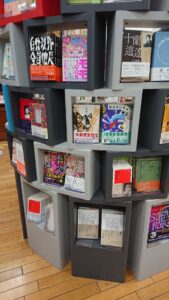Special Column | ASIA IN RESONANCE 2019 GALA CONCERT | Haruka Kanoh
ASIA IN RESONANCE 2019 GALA CONCERT:
Gazing upon Resonating Future of Asia
Text by Haruka Kanoh
Translated by Maako Shiratori
Photos by Fumiaki Fujimoto/Provided by Association of Japanese Symphony Orchestras
On July 1, 2019, the Tokyo Metropolitan Theatre held the “Asia in Resonance 2019 Gala Concert.” Musicians from five Southeast Asian countries――Indonesia, Thailand, the Philippines, Vietnam and Myanmar――and Japan, gathered on stage that day. It was obvious, from a glance at the packed seats, that this multinational Asian orchestra had drawn many people’s attention in Japan.
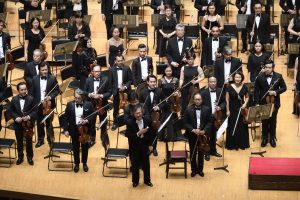 The concert was organised by the Japan Foundation as the fruit of the five-year long “ASEAN Orchestra Support Project.” The project began in 2014 to enhance performance skills of orchestras in the Association of Southeast Asian Nations member countries and cultivate management staff. According to Self-Assessment Report 2014 of the foundation, the project was set up on the assumption that “the ASEAN nations are still in the process of preparing cultural infrastructures and Japan needs to further develop and strengthen a cultural relationship with them, as well as political and economic ties.” The program booklet of the concert explains that the project includes three programs. In the first program, Japanese musicians are sent on a long-term dispatch to local orchestras in Southeast Asia so that they can promote cooperation and cultural exchange through their activities as an orchestra member. The second program involves inviting management staff to Japan for a short-term training. The third is on support efforts for the Myanmar National Symphony Orchestra, which restarted its activity in 2012 after the nation’s transfer of power to the civilian government. The three programs are also part of “Strengthening Cultural Exchange in Asia” project mainly by the Asia Centre, established by the Japan foundation in 2014. The concert marked the start of “Asia in Resonance,” a cultural exchange festival hosted by the center.
The concert was organised by the Japan Foundation as the fruit of the five-year long “ASEAN Orchestra Support Project.” The project began in 2014 to enhance performance skills of orchestras in the Association of Southeast Asian Nations member countries and cultivate management staff. According to Self-Assessment Report 2014 of the foundation, the project was set up on the assumption that “the ASEAN nations are still in the process of preparing cultural infrastructures and Japan needs to further develop and strengthen a cultural relationship with them, as well as political and economic ties.” The program booklet of the concert explains that the project includes three programs. In the first program, Japanese musicians are sent on a long-term dispatch to local orchestras in Southeast Asia so that they can promote cooperation and cultural exchange through their activities as an orchestra member. The second program involves inviting management staff to Japan for a short-term training. The third is on support efforts for the Myanmar National Symphony Orchestra, which restarted its activity in 2012 after the nation’s transfer of power to the civilian government. The three programs are also part of “Strengthening Cultural Exchange in Asia” project mainly by the Asia Centre, established by the Japan foundation in 2014. The concert marked the start of “Asia in Resonance,” a cultural exchange festival hosted by the center.
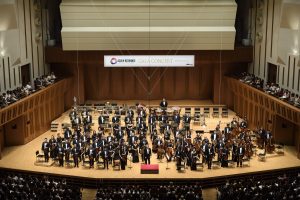 The “Asia in Resonance 2019” orchestra included 32 participants from the Ho Chi Minh City Ballet Symphony Orchestra and Opera, five from the Vietnam National Symphony Orchestra, 20 from the Royal Bangkok Symphony Orchestra, 11 from the Philippine Philharmonic Orchestra, four from the Manila Symphony Orchestra, three from the Myanmar National Symphony Orchestra, three from the Jakarta City Philharmonic, and three from the Jakarta Sinfonietta. From Japan, six musicians, who participated in the long-term dispatch to be a part of the Southeast Asian orchestras, and fourteen special guests were also in the orchestra. The 14 included Ryuji Tomono, a “wadaiko” Japanese drum player, and Asuka Sezaki, who served as a concertmistress and solist. A total of 36 brass instrument players from Iwakura High School’s brass band also made an appearance. Kenichiro Kobayashi, dubbed “Hono no Kobaken” or Kobaken (Kobayashi) on fire, served as conductor and Satoshi Asaoka as master of ceremonies.
The “Asia in Resonance 2019” orchestra included 32 participants from the Ho Chi Minh City Ballet Symphony Orchestra and Opera, five from the Vietnam National Symphony Orchestra, 20 from the Royal Bangkok Symphony Orchestra, 11 from the Philippine Philharmonic Orchestra, four from the Manila Symphony Orchestra, three from the Myanmar National Symphony Orchestra, three from the Jakarta City Philharmonic, and three from the Jakarta Sinfonietta. From Japan, six musicians, who participated in the long-term dispatch to be a part of the Southeast Asian orchestras, and fourteen special guests were also in the orchestra. The 14 included Ryuji Tomono, a “wadaiko” Japanese drum player, and Asuka Sezaki, who served as a concertmistress and solist. A total of 36 brass instrument players from Iwakura High School’s brass band also made an appearance. Kenichiro Kobayashi, dubbed “Hono no Kobaken” or Kobaken (Kobayashi) on fire, served as conductor and Satoshi Asaoka as master of ceremonies.
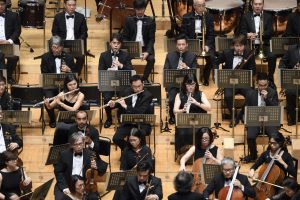 It was on June 27 that these musicians from different countries met one another for the first time. Although the orchestra members were given little time to rehearse before the concert, each piece was performed passionately and full of life under the baton of Kobayashi. Kobayashi brought together, with unrestrained sounds played by each individual member, while leaving a little space to explore. The orchestra’s melody was not simply musical notes played by each member in sync. Rather, the music, born by actively moving sounds meeting and intertwining, contained a vibrant power and undulated like waves within the concert hall. While feeling as if I was drawn into the waves, I was reminded of the countless performances by Vietnamese musicians I had heard during my stay in the country. I was also washed over with a warm sensation as I was reunited with people who I befriended in Vietnam at the concert. Although each member of the audience may have their own experience of the concert, the hall was filled with loud cheers and applauses after all the performances.
It was on June 27 that these musicians from different countries met one another for the first time. Although the orchestra members were given little time to rehearse before the concert, each piece was performed passionately and full of life under the baton of Kobayashi. Kobayashi brought together, with unrestrained sounds played by each individual member, while leaving a little space to explore. The orchestra’s melody was not simply musical notes played by each member in sync. Rather, the music, born by actively moving sounds meeting and intertwining, contained a vibrant power and undulated like waves within the concert hall. While feeling as if I was drawn into the waves, I was reminded of the countless performances by Vietnamese musicians I had heard during my stay in the country. I was also washed over with a warm sensation as I was reunited with people who I befriended in Vietnam at the concert. Although each member of the audience may have their own experience of the concert, the hall was filled with loud cheers and applauses after all the performances.
For five years, the ASEAN Orchestra Support Project have prepared a platform in which people from Japan and Southeast Asian countries get to know, interact and cooperate with each other through performances by orchestras and supporting such groups’ management. Although my experiences on the project were fragmented and based mainly in Vietnam, I had some opportunities to see the interactions between people firsthand and listen to their voices. I saw the participants reach beyond borders and regions to share the same experience. While still flimsy and faint, a new relationship between Japan and the Southeast Asian countries and a new shared image of Asia were being built by the participants. Prior to and during the World War Ⅱ, Japan colonised the region under the ideology of Greater East Asia Co-Prosperity Sphere. Even today, the two share an unequal relation, as seen in the issues of the Japanese government’s Technical Intern Training Program. The accumulation of shared experiences in the project, however, may be our best hope to dismantle the stubbornly placed ties and recreate a new one.
On the other hand, we need to be careful when we evaluate the project, given the history and the situation of such times. We cannot ignore the global hierarchy in music just as symphony orchestras, with the European countries and the United States on top, followed by Japan and then Asia. Japan has tackled Western music, in hopes to catch up with the West and the project was started on the premises that Japan is more advanced than Southeast Asian countries in terms of performance and management of orchestras.
I found at least two kinds of images on Asia at the concert, which was held in culmination of the project. The first one is a new image of Asia, which includes Southeast Asia nations and Japan, built up through each steady activity. This concert was realised as a product of the five-year exchange process, mainly bilateral exchanges. As musicians from Southeast Asian nations and Japan assembled one orchestra to create a close and warm moment with the audience, it can be said that they took a step further than the previous efforts.
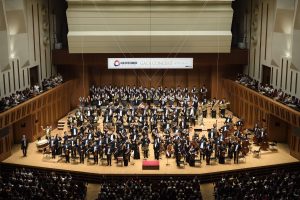 The second image of Asia reminds us of Edward Said’s Orientalism. During the concert, some specific words, such as “the power of Asia,” “energy” and “vigour,” were repeated. These terms are embodied in the dynamic conducting skills by Kobayashi, powerful performances of the pieces in the concert program starting with the “Triumphal March” from Aida, and the audience’s cheers and applause actively responding to the performances. The power of Asia, which appears beautiful, was the theme of the concert throughout the program. While gazing the aforementioned budding, delicate images of Asia, the image of the power of Asia, which was the ideal image of the “Other” by Said for Japan, was violently created by pouring the image into a mold and presented at the concert. This image of Asia, which has already spread among the people in Japan with the astonishing economic development of Southeast Asia in recent years, is not unrelated to the situation that the “power” of the region, including those of the market and of manpower, is essential to Japan now. I am not denying the power of Asia itself. Instead, I am raising a question about the display of such image by the Japan Foundation, which upholds the aim “to nurture among the people of Asia a common awareness for mutual coexistence and understanding,” bringing a standstill or regression, rather than progress, in achieving such goals, and causing division rather than a connection.
The second image of Asia reminds us of Edward Said’s Orientalism. During the concert, some specific words, such as “the power of Asia,” “energy” and “vigour,” were repeated. These terms are embodied in the dynamic conducting skills by Kobayashi, powerful performances of the pieces in the concert program starting with the “Triumphal March” from Aida, and the audience’s cheers and applause actively responding to the performances. The power of Asia, which appears beautiful, was the theme of the concert throughout the program. While gazing the aforementioned budding, delicate images of Asia, the image of the power of Asia, which was the ideal image of the “Other” by Said for Japan, was violently created by pouring the image into a mold and presented at the concert. This image of Asia, which has already spread among the people in Japan with the astonishing economic development of Southeast Asia in recent years, is not unrelated to the situation that the “power” of the region, including those of the market and of manpower, is essential to Japan now. I am not denying the power of Asia itself. Instead, I am raising a question about the display of such image by the Japan Foundation, which upholds the aim “to nurture among the people of Asia a common awareness for mutual coexistence and understanding,” bringing a standstill or regression, rather than progress, in achieving such goals, and causing division rather than a connection.
On the path to the 2020 Tokyo Olympic and Paralympic Games, the Japan Foundation has put a great deal of effort into the projects related to Asia. How should we judge the activities implemented in the last five years and how do we make the most of them for the future? What we think and how we act will lead us to what role Japan should play in Asia in the future, as well as what position the country should take in the world after the 2020 Games. The concert has left us with many questions. With various projects and events concerning Asia are being held, everyone, including organisers, musicians, the audience, those who provide aid and the receivers, have to reflect, be critical, and positive at all times so that we can open up to the future and make Asia in resonance.
This Article in Japanese: 特別寄稿|「響きあうアジア2019」ガラコンサートで考える〜アジアの未来・響生〜|加納遥香
References
“Asia in Resonance 2019” Gala Concert. Program booklet.
Edward W. Said. 1978. Orientalism, Pantheon Books.
(Aug. 15. 2019)
—————————————————————————
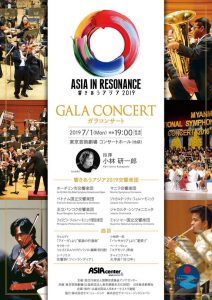 ASIA IN RESONANCE 2019 GALA CONCERT
ASIA IN RESONANCE 2019 GALA CONCERT
Tokyo Metropolitan Theatre Concert Hall
July 1, 2019
Conductor:Ken-ichiro Kobayashi
Violin (Concertmistress & Solo):Asuka Sezaki
MC:Satoshi Asaoka
Orchestra: Asia in Resonance 2019 Symphony Orchestra
Program
Verdi: Triumphal March from Aida
Sarasate: Zigeunerweisen Op.20
Sibelius: Finlandia Op.26
Ken-ichiro Kobayashi: Festival from Passacaglia
- Intermission (20 mins) –
Beethoven: Overture Egmont Op.84
Tchaikovsky: Overture 1812
Reference available here
English: https://jfac.jp/en/culture/events/e-asia2019-gala-concert/
Japanese: https://jfac.jp/culture/events/e-asia2019-gala-concert/
———————————————————————————————–
Haruka Kanoh is a Ph.D. student at the Institute for the Study of Global Issues, Graduate School of Social Sciences, Hitotsubashi University, where she conducts research on the construction of musical cultures, with special emphasis on opera in Socialist Vietnam. After studying at Vietnam National University, Hanoi from 2014 to 2016, she received her M.A. in Sociology from Hitotsubashi University with a thesis entitled Vietnamese Opera as Cultural Representation: Art and Power in Socialist Vietnam in 2017. She is also a Research Fellow of Japan Society for the Promotion of Science.
Maako Shiratori is a M.A. student in Music and Culture Program of Appalachian Studies at Appalachian State University. She conducts research on Appalachian ballads and folktales. Prior to coming to AppState U, she received her B.A. in English Literature from Keio University in 2017 and M.A. from Graduate School for Language and Society, Hitotsubashi University in 2019.
